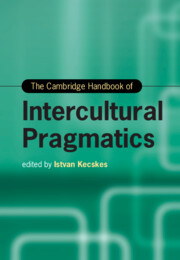Book contents
- The Cambridge Handbook of Intercultural Pragmatics
- Cambridge Handbooks in Language and Linguistics
- The Cambridge Handbook of Intercultural Pragmatics
- Copyright page
- Contents
- Figures
- Tables
- Acknowledgment
- Contributors
- Introduction The Rise of Intercultural Pragmatics
- Part I Theoretical Foundation
- Part II Key Issues in Intercultural Pragmatics Research
- Part III Interface of Intercultural Pragmatics and Related Disciplines
- Part IV Intercultural Pragmatics in Different Types of Communication
- 21 Visual and Multimodal Communication across Cultures
- 22 Intercultural Teamwork via Videoconferencing Technology: A Multimodal (Inter)action Analysis
- 23 Intercultural Communication in Computer-Mediated Discourse
- 24 Intercultural Aspects of Business Communication
- 25 Intercultural Pragmatics in Healthcare Communication
- 26 Academic and Professional Discourse in Intercultural Pragmatics
- 27 The Dynamic Model of Meaning Approach: Analyzing the Interculturality of Conspiracy Theory in Far-Right Populist Discourses
- Part V Language Learning
- Index
- References
24 - Intercultural Aspects of Business Communication
from Part IV - Intercultural Pragmatics in Different Types of Communication
Published online by Cambridge University Press: 29 September 2022
- The Cambridge Handbook of Intercultural Pragmatics
- Cambridge Handbooks in Language and Linguistics
- The Cambridge Handbook of Intercultural Pragmatics
- Copyright page
- Contents
- Figures
- Tables
- Acknowledgment
- Contributors
- Introduction The Rise of Intercultural Pragmatics
- Part I Theoretical Foundation
- Part II Key Issues in Intercultural Pragmatics Research
- Part III Interface of Intercultural Pragmatics and Related Disciplines
- Part IV Intercultural Pragmatics in Different Types of Communication
- 21 Visual and Multimodal Communication across Cultures
- 22 Intercultural Teamwork via Videoconferencing Technology: A Multimodal (Inter)action Analysis
- 23 Intercultural Communication in Computer-Mediated Discourse
- 24 Intercultural Aspects of Business Communication
- 25 Intercultural Pragmatics in Healthcare Communication
- 26 Academic and Professional Discourse in Intercultural Pragmatics
- 27 The Dynamic Model of Meaning Approach: Analyzing the Interculturality of Conspiracy Theory in Far-Right Populist Discourses
- Part V Language Learning
- Index
- References
Summary
Business communication is becoming increasingly intercultural and much more complex in the face of the globalized business arena and workforce diversity (Varner, 2000; Yuan, 1997; Zaidman, 2001). This trend has highlighted the need for understanding the role of culture and language use in business communication. It deserves a close look at how people from different linguacultural backgrounds come into contact and achieve successful interaction with one another in business communication. This chapter aims to survey the research on business communication and discuss its various aspects to help us better understand business communication from an intercultural pragmatics perspective. It consists of three sections after a general introduction and before a conclusion: (1) business communication and culture; (2) major business communication genres (i.e. business meetings, call center exchanges, emails and social media platforms); (3) main research areas and topics.
- Type
- Chapter
- Information
- The Cambridge Handbook of Intercultural Pragmatics , pp. 612 - 651Publisher: Cambridge University PressPrint publication year: 2022

